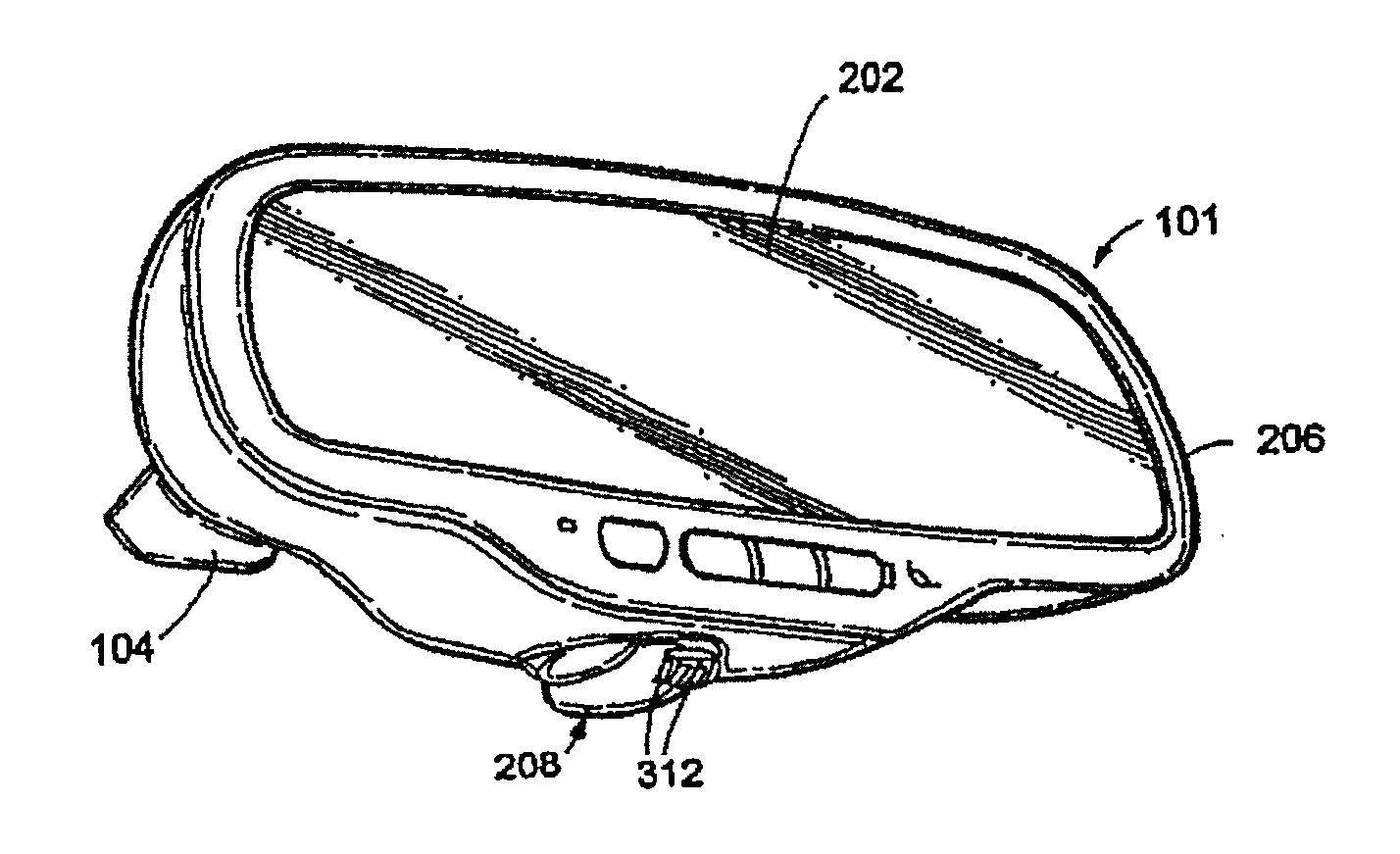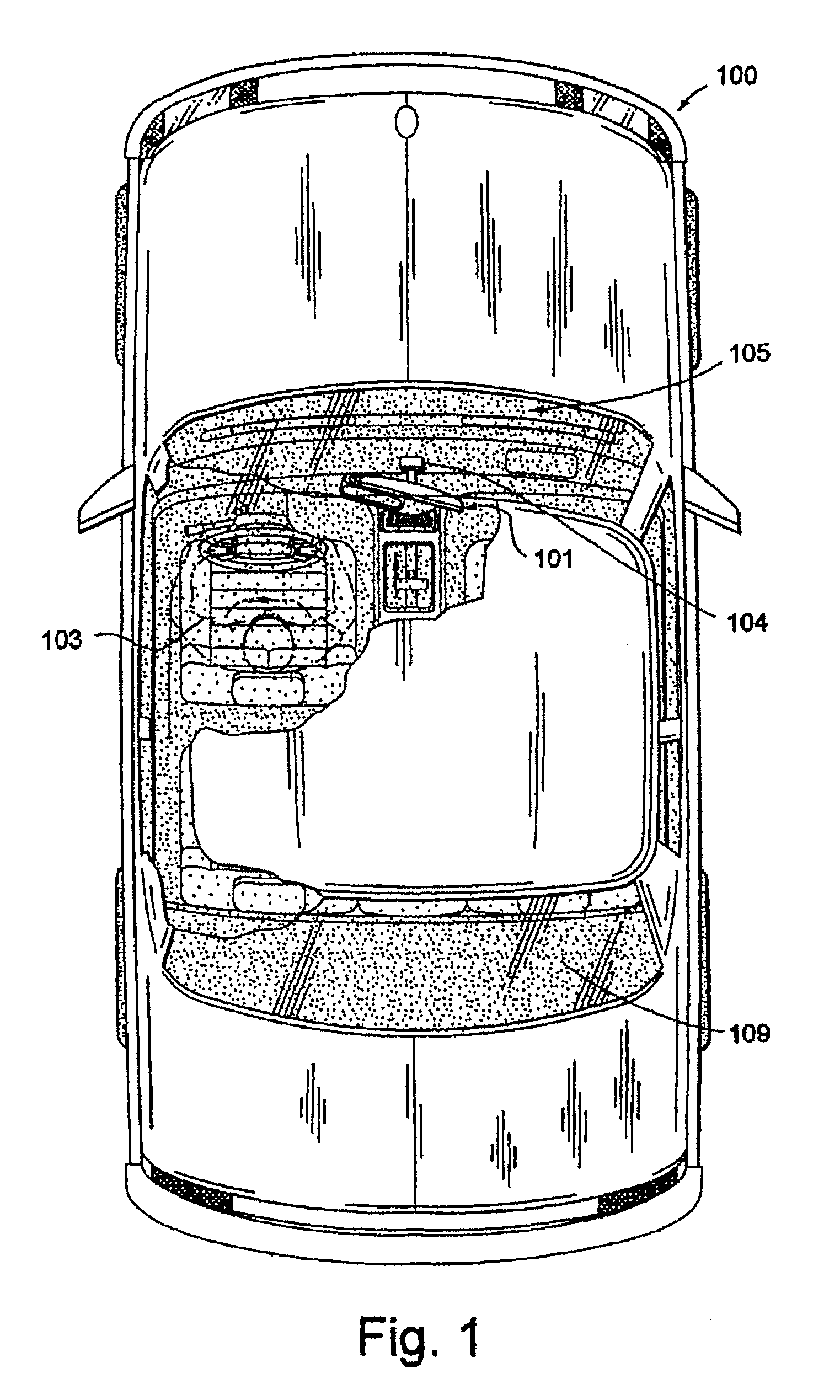Vehicle accessory microphone
a technology for accessories and microphones, applied in the field of vehicles, can solve the problems of difficult to attenuate noise, detect undesirable noise, and difficult to use hands-free communication systems for vehicles
- Summary
- Abstract
- Description
- Claims
- Application Information
AI Technical Summary
Problems solved by technology
Method used
Image
Examples
first embodiment
[0103]The rearview mirror assembly 101 is enlarged in FIG. 2. The mirror assembly 101 includes an elongated housing 206 pivotably carried on mirror support 104. The mirror 202 may be any conventional interior rearview mirror, such as a prismatic mirror of the type used with a mirror housing manually adjustable for daytime and nighttime operation, or a multiple element mirror effecting automatic reflectivity adjustment, such as an electrooptic or electrochromic mirror. The elongated housing 206 may be of any conventional manufacture such as integrally molded plastic.
[0104]The rearview mirror assembly 101 further includes a microphone assembly 208 that is preferably mounted to the housing 206 at a location visible to the vehicle driver 103 or at a position which is direct line of sight between the speaker's mouth and the microphone. It is advantageous for the microphone assembly 208 to be positioned on the mirror housing 206 as the mirror assembly is movably carried on the support 10...
second embodiment
[0259]A preferred second embodiment of an interior rearview mirror assembly 4101 of the present invention is shown in FIGS. 54A-54D. The front view of interior rearview mirror assembly 4101 is not shown insofar as its appearance would be similar to the interior rearview mirror assembly 4001 shown in FIG. 53A. As shown in FIGS. 54A-54D and as described below, the microphone assemblies 4120a and 4120b are also mounted on the back surface 4107 of the mirror housing 4106 and are not visible from the front of the mirror assembly.
[0260]The microphone assemblies 4120a and 4120b are preferably mounted on the mirror assembly and may be substantially identical. Only one of the two microphone assemblies is shown and described in detail. Microphone assembly 4120a includes a microphone housing 4115, a transducer 4125, and a circuit board 4126. The microphone housing 4115 (FIGS. 55-57) is generally rectangular, although the housing could have a generally square foot print, an elongated elliptical...
third embodiment
[0300]The acoustic dam 4230 forces a definition of the ports 4216, 4217, and 4218 that will contribute to the front and those that will add up to be the rear signal. There will be a center of area that will act as the virtual location for the front and another for the rear. A line through these two centers will form the aiming axis independent of the transducer orientation. In this third depicted embodiment, the rear zones are formed such that the driver-facing microphone transducer 4225a will aim more into the cab and the rear of the passenger-facing transducer 4225b aims more away from the cab. This is accomplished by changing to which side of the acoustic dam 4230 the rear ports 4218 connect. In this third embodiment, acoustic dam 4230 extends from the top of the circuit board to the top inner surface of the microphone housing 4215 and extends tightly around all of the upper peripheral edge of transducer 4225a and tightly around half of the upper peripheral edge of transducer 422...
PUM
 Login to View More
Login to View More Abstract
Description
Claims
Application Information
 Login to View More
Login to View More - R&D
- Intellectual Property
- Life Sciences
- Materials
- Tech Scout
- Unparalleled Data Quality
- Higher Quality Content
- 60% Fewer Hallucinations
Browse by: Latest US Patents, China's latest patents, Technical Efficacy Thesaurus, Application Domain, Technology Topic, Popular Technical Reports.
© 2025 PatSnap. All rights reserved.Legal|Privacy policy|Modern Slavery Act Transparency Statement|Sitemap|About US| Contact US: help@patsnap.com



